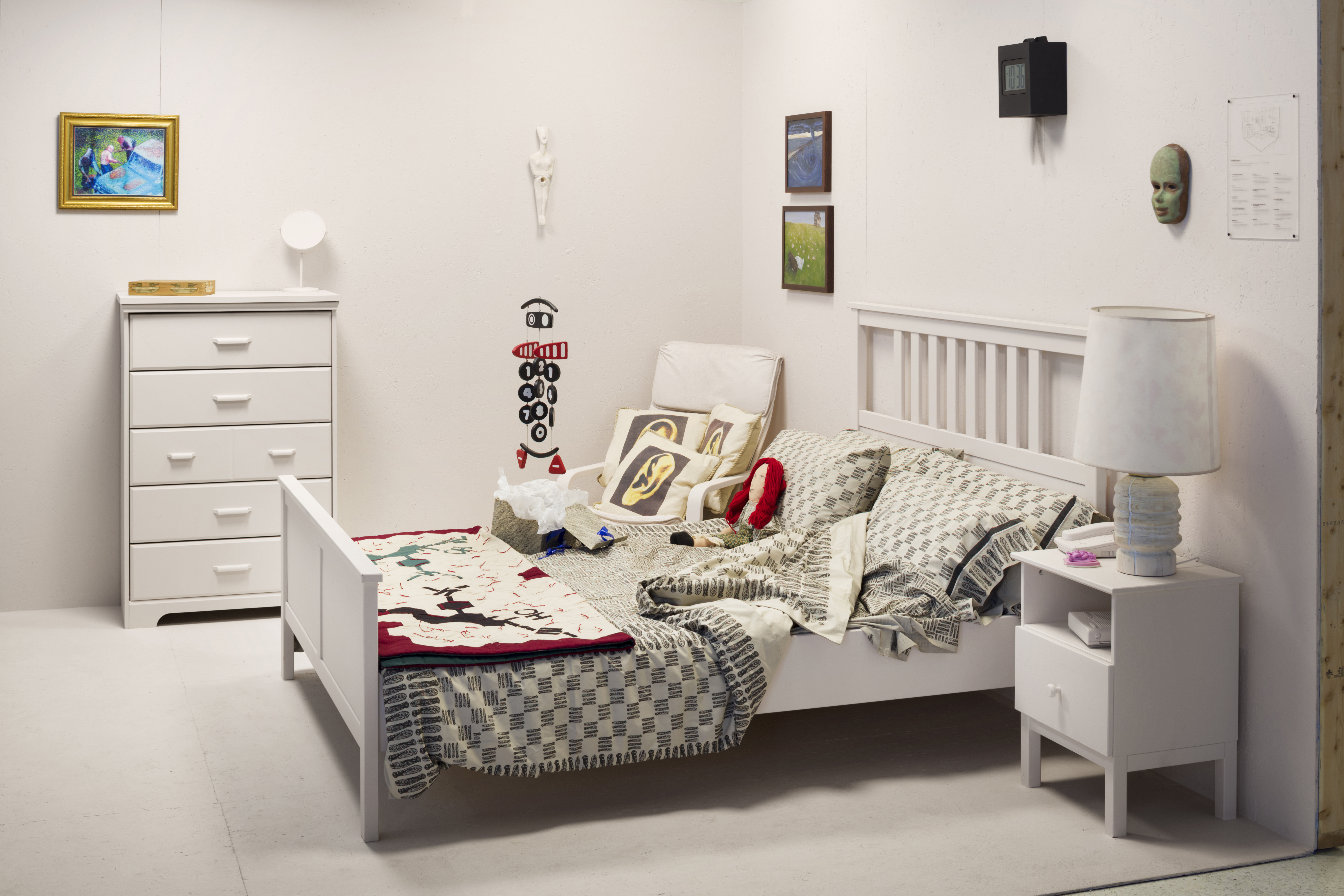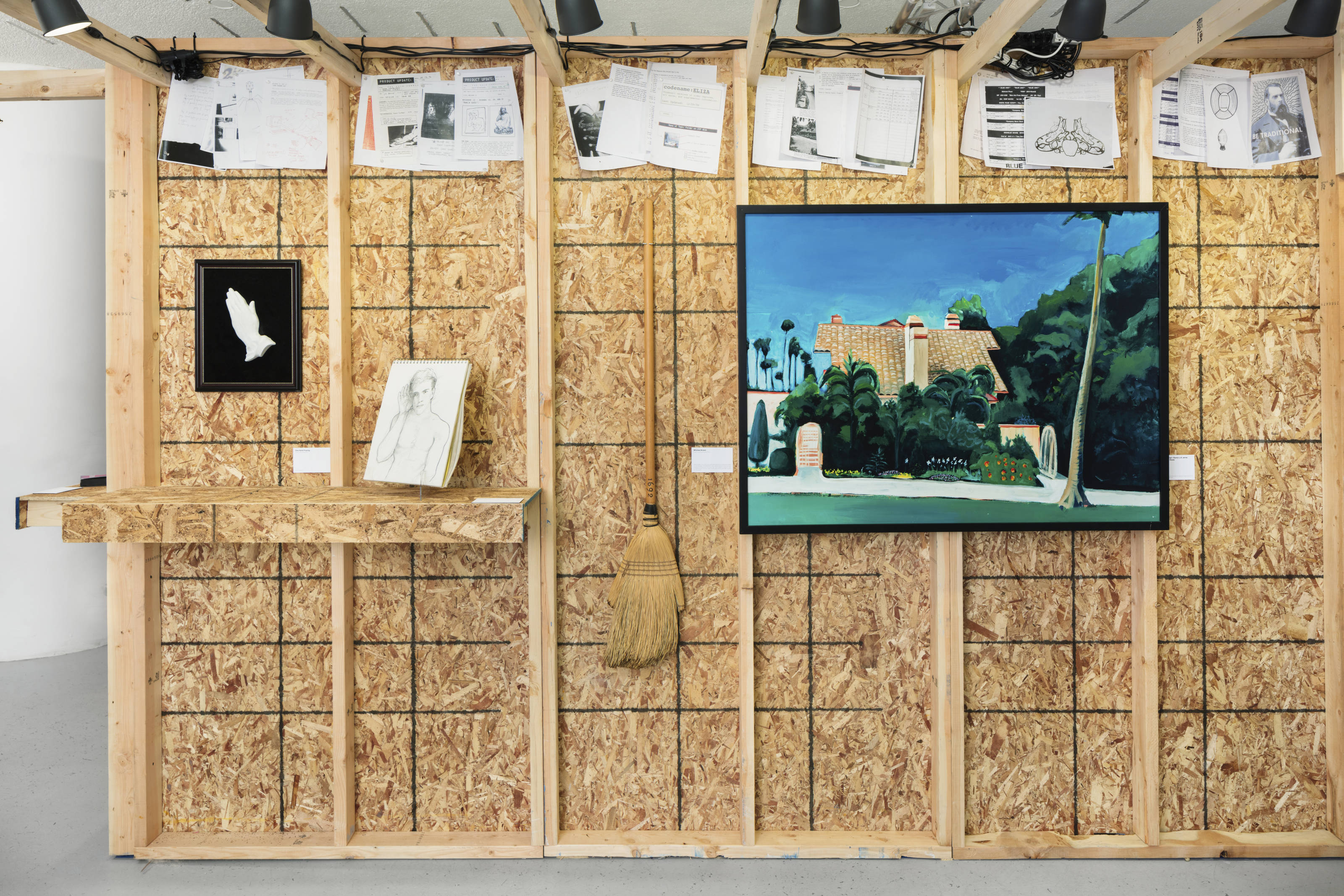
Total Proof:
The Gala Committee 1995-1997
September 30th - November 27th, 2016
Red Bull Arts
New York
In 1995, the Museum of Contemporary Art in Los Angeles (MOCA) invited artist Mel Chin to participate in a group
show titled Uncommon Sense, which aimed to explore new possibilities for public engagement in the greater Los
Angeles community. Chin responded by forming a collective that came to be known as the GALA Committee. In
a radical reimagining of the space and method for artistic intervention, the group of artists conspired with Aaron
Spelling’s production team to integrate a body of politically provocative artworks into the set of the primetime soap
opera Melrose Place. Over two seasons, the GALA Committee inserted over one hundred works as props into the
show. They called this project In the Name of the Place.
Building upon Chin’s interest in viral methodology as a means to transmit ideas for social transformation, the pervasive landscape of syndicated mass media would become a powerful site for the collective’s sustained public artwork. If GALA’s work was the virus, Melrose Place was the host, and the ten million weekly viewers were the intended carriers of this infection of ideas.
Countering the dominant construct of the individual artist, GALA playfully and powerfully brought together art historical references, current social and political events and Melrose Place plotlines and characters. The insertions, which began as an infiltration of a host, ultimately became a symbiotic relationship of reciprocal influence and adaptation. Melrose Place scripts were distributed in advance to GALA members who then created pieces to address specific plot points and themes. Meanwhile, Melrose Place writers developed characters (most notably Sam, a painter) and storylines in response to GALA’s presence. The ultimate example of this viral corollary was a scene written into the television show in which Amanda and Kyle attend a fictional opening of the actual In the Name of the Place installation at MOCA.
With covert, charged information and images embedded into its sets, Melrose Place became a new type of invasive entity while still functioning and recognizable as the wildly popular soap opera of its time, dedicated to entertainment through sexual intrigue and exaggerated personal drama. Through the transmission of television, the DNA of the project filtered into its audience watching on air and in re-runs, and continues to exert its influence.
In the Name of the Place was not meant to be subversive; rather, it sought to utilize the reach of commercial television to promote a generational transfer of ideas and expand its potential for complex, multi-dimensional content. Inspired by the efficacy of viral transmission, and a trust in collaboration, GALA created a blueprint for cooperative expression with the intent that it could spur a new model for the communication of ideas.
TOTAL PROOF: The GALA Committee 1995-1997 presented, for the first time in New York, a comprehensive exhibition of In the Name of the Place. Designed as a reinterpretation of a Spelling-era TV set, the exhibition features the show’s most significant locales, including a site-specific rendition of the infamous Melrose Place pool. In addition to the works, the show highlights GALA’s working method through archival documents—facsimile communiqués, sketches and other ephemera—which attest to the complexities of this project and the broad network of anonymous artists that powered this pioneering intervention.
Gala Committee: David Adams, Elizabeth Adams, Eric Andersen, Emily Arthur, Katie Bauman, Cameron Bernie, David Blanchar, John Borthwick, Barron Brown, Alan Bush, Heather Champ, Heeyeon Chang, Mel Chin, Lance Clarke, Roymont Clement, Kathleen Hillseth Clinesmith, Karina Combs, Melissa Conroy, John Crowe, John Cupit, Lesley Dill, Heather M. Eastman, Diane Ediso, Brian Ellison, Evan Firestone, Mark Flood, Joe Girandola, Terry Glispin, Nuala Glynn, Jason Grier, Garrison Gunter, Elizabeth Hube, Chip Hayes, Frank Irving, Kim Jensen, Bryan Jernigan, Karin Johansson, M. Dana Jones, Cheryl Kaplan, Kendal Kerr, Kat Kinsma, Koichi Kimura, Jeff Knowlton, Leo Knox, Bernie Koersen, H. Lan Thao Lam, Ed Lambert, Elizabeth Langford, Jon Lapointe, Tom Lawso, Kristi Leonard, Donna Marcantonio , Diana McIntosh, Mara Lonner, Wendy Lundin, Steve Maleski, Thomas Man, Stephen, McRedmond, Carol Mendelsohn, Georgia Metz, Tamara Mewis, James Millar, Steve Miller, Tamalyn Miller, Tess Miller, Dallas Moor, Margaret Morgan, Jerry Murphy, Helen K. Nagge, Yana Nirvana, Gail Patterson, Kim Patterson, Constance Penley, Joseph Pizzoruss, Chuck Pratt, Elizabeth S. Puckett, Dan Pugh, Martha Rees, Carl Robertson, Guadalupe Rodriguez, Sandra Rodriguez, Jeff Ro, Kathleen Rogan, Haun Saussy, Sanjit Sethi, Maura Sheehan, Jocelyn Shipley, Eric Shriner, Deborah Siegel, Rachel Slowinsk, Frank South, Rachael Splinter, Eric Swangstu, Troy Swangstu, Janice Tanaka, Valerie Tevere, Joseph Tucker, Kathy Vargas, Tony Velasco, Jim Wade, John Watts, David Wilson
Building upon Chin’s interest in viral methodology as a means to transmit ideas for social transformation, the pervasive landscape of syndicated mass media would become a powerful site for the collective’s sustained public artwork. If GALA’s work was the virus, Melrose Place was the host, and the ten million weekly viewers were the intended carriers of this infection of ideas.
Countering the dominant construct of the individual artist, GALA playfully and powerfully brought together art historical references, current social and political events and Melrose Place plotlines and characters. The insertions, which began as an infiltration of a host, ultimately became a symbiotic relationship of reciprocal influence and adaptation. Melrose Place scripts were distributed in advance to GALA members who then created pieces to address specific plot points and themes. Meanwhile, Melrose Place writers developed characters (most notably Sam, a painter) and storylines in response to GALA’s presence. The ultimate example of this viral corollary was a scene written into the television show in which Amanda and Kyle attend a fictional opening of the actual In the Name of the Place installation at MOCA.
With covert, charged information and images embedded into its sets, Melrose Place became a new type of invasive entity while still functioning and recognizable as the wildly popular soap opera of its time, dedicated to entertainment through sexual intrigue and exaggerated personal drama. Through the transmission of television, the DNA of the project filtered into its audience watching on air and in re-runs, and continues to exert its influence.
In the Name of the Place was not meant to be subversive; rather, it sought to utilize the reach of commercial television to promote a generational transfer of ideas and expand its potential for complex, multi-dimensional content. Inspired by the efficacy of viral transmission, and a trust in collaboration, GALA created a blueprint for cooperative expression with the intent that it could spur a new model for the communication of ideas.
TOTAL PROOF: The GALA Committee 1995-1997 presented, for the first time in New York, a comprehensive exhibition of In the Name of the Place. Designed as a reinterpretation of a Spelling-era TV set, the exhibition features the show’s most significant locales, including a site-specific rendition of the infamous Melrose Place pool. In addition to the works, the show highlights GALA’s working method through archival documents—facsimile communiqués, sketches and other ephemera—which attest to the complexities of this project and the broad network of anonymous artists that powered this pioneering intervention.
Gala Committee: David Adams, Elizabeth Adams, Eric Andersen, Emily Arthur, Katie Bauman, Cameron Bernie, David Blanchar, John Borthwick, Barron Brown, Alan Bush, Heather Champ, Heeyeon Chang, Mel Chin, Lance Clarke, Roymont Clement, Kathleen Hillseth Clinesmith, Karina Combs, Melissa Conroy, John Crowe, John Cupit, Lesley Dill, Heather M. Eastman, Diane Ediso, Brian Ellison, Evan Firestone, Mark Flood, Joe Girandola, Terry Glispin, Nuala Glynn, Jason Grier, Garrison Gunter, Elizabeth Hube, Chip Hayes, Frank Irving, Kim Jensen, Bryan Jernigan, Karin Johansson, M. Dana Jones, Cheryl Kaplan, Kendal Kerr, Kat Kinsma, Koichi Kimura, Jeff Knowlton, Leo Knox, Bernie Koersen, H. Lan Thao Lam, Ed Lambert, Elizabeth Langford, Jon Lapointe, Tom Lawso, Kristi Leonard, Donna Marcantonio , Diana McIntosh, Mara Lonner, Wendy Lundin, Steve Maleski, Thomas Man, Stephen, McRedmond, Carol Mendelsohn, Georgia Metz, Tamara Mewis, James Millar, Steve Miller, Tamalyn Miller, Tess Miller, Dallas Moor, Margaret Morgan, Jerry Murphy, Helen K. Nagge, Yana Nirvana, Gail Patterson, Kim Patterson, Constance Penley, Joseph Pizzoruss, Chuck Pratt, Elizabeth S. Puckett, Dan Pugh, Martha Rees, Carl Robertson, Guadalupe Rodriguez, Sandra Rodriguez, Jeff Ro, Kathleen Rogan, Haun Saussy, Sanjit Sethi, Maura Sheehan, Jocelyn Shipley, Eric Shriner, Deborah Siegel, Rachel Slowinsk, Frank South, Rachael Splinter, Eric Swangstu, Troy Swangstu, Janice Tanaka, Valerie Tevere, Joseph Tucker, Kathy Vargas, Tony Velasco, Jim Wade, John Watts, David Wilson





















